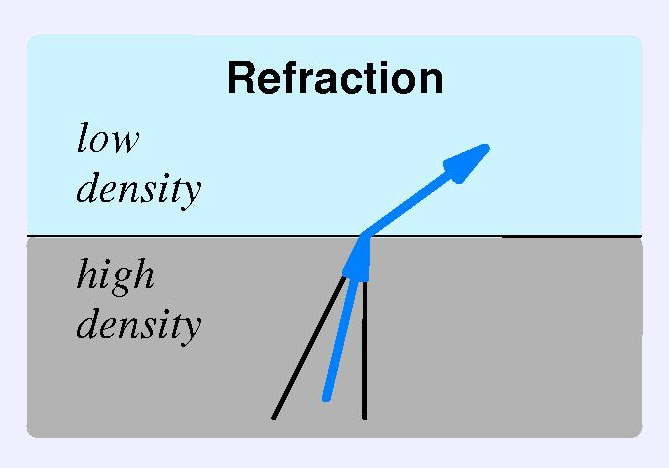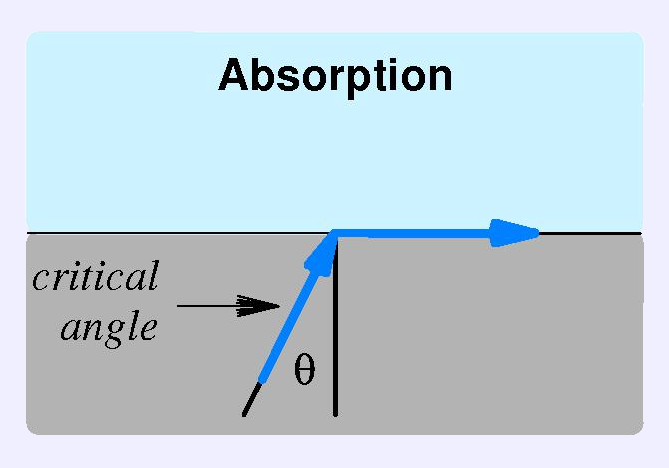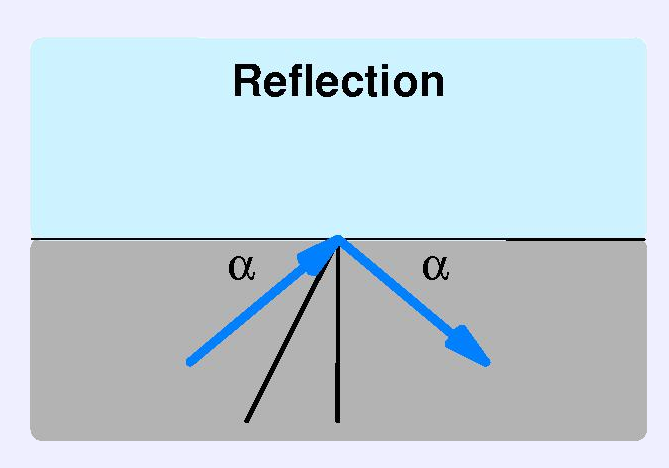- Transmission media
- Guided: Wire or other conduit.
- Unguided: Not.
- Taxonomy.
- Electricity
- Twisted pair wire.
- Coaxial cable.
- Light
- Optical fiber.
- Infrared.
- Laser.
- Radio
- Terrestrial
- Satellite
- Wire
- Must form a circuit, so you need two.
- Metal wires absorb energy from stray random electromagnetic
radiation on the environment: noise.
- Wire pair subject to interference.
Different effects on each wire.

- Twisting them can reduce the damage. The effect adds up to
the same in each direction.

Ethernet uses twisted pair.
- Coaxial uses the ground as a shield for the positive.
Effect on the shield is balanced.

Cable TV and cable internet.
- Twisted pair may also be shielded.
- Shielding makes the cable less flexible.
- Electromagnetic spectrum.
Radio and light are electromagnetic radiation on a spectrum of
frequencies.

- Different frequencies behave differently.
- Lower frequencies travel farther and better penetrate objects.
- Short-wave radio signals travel around the world.
- AM radio is higher frequency, but still can travel a great distance.
- FM radio and TV signals usually cover a city.
- Microwaves will penetrate walls, but infrared and light do not.
- Optical cable.
- A physical cable which guides a visible light signal.
- Transparent materials have different optical densities.
- When light travels between materials of different type, it is
refracted or reflected, depending on the densities and angle.
- Optical fiber uses a central core and a cladding of lower
density.
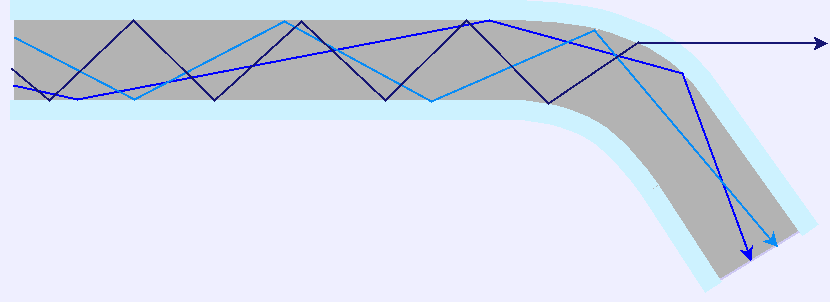
- Relies on the internal reflection to keep the light inside.
- Sharp bends will let the light escape.
- Light started at different angles will have different travel times.
Called “diffusion.”

- Types
- Multimode, step index. Cheapest. Sharp density change at
the cladding produces sharp reflection and more diffusion.
- Multimode, graded index. Medium cost. Gradual density change
reduces diffusion.
- Single mode. Most expensive. Very narrow core to minimize
diffusion.
- Wiring v. Optical fiber
- Wire is cheaper.
- Optical does not suffer from interference.
- Optical supports higher bandwidth.
- Optical is easier to break and more difficult to repair.
- Infrared
- Same frequencies as used for remote controls.
- Line-of-sight: Won't go around corners or through walls, but
produces a wide beam.
- Used for nearby peripherals, such as a printer.
- Has been used to synchronize a PDA.
- Don't see it much now.
- Unguided Laser
- Creates a narrow point-to-point, line-of-sight link.
- Endpoint devices must be carefully aligned.
- Used out-of-doors, such as between adjacent buildings.
- Can also be used to link a mountaintop to nearby city, or cross a
body of water.
- Rain, fog and smoke tend to block the channel.
- Terrestrial Radio
- Radio and TV frequencies are not usually used with computer networks,
but may carry digital media.
- There is an old practice of using short wave for computer
networking. Seems mainly a hobby thing.
- Most common is WiFi, which is in the microwave range.
- As we will see later, higher frequencies are can support higher
bandwidth. (That's probably why we don't just run the Internet
over shortwave, and save a bunch on infrastructure.)
- Satellites
- Radio signals in the microwave band are sent to a satellite, which
relays them back to another location on earth.
- Some physics.
- A satellite must move, otherwise it falls to earth.
- In general, an orbit is an ellipse, but we usually use
circular ones.
- Speed depends on altitude. The higher, the slower.
- God chooses the combinations of speed and altitude; you don't
get to write your own natural laws.
- Geostationary (aka geosynchronous) satellites.
Satellites won't stay in one place, but this gets pretty close.
- Use a circular orbit over the equator.
- Set the speed so that the orbital period is 1 day.
- Now the (moving) satellite is synchronized with the rotation
of the earth,
so it appears fixed from any observation point on the
(rotating) earth.
- The required height is 22,236 miles.
- Problems with geostationary satellites.
- The round-trip time to the sat and back is more than 0.2 sec.
- Ground stations need considerable power to send a signal that
distance.
- Since the signal must be sent to just one satellite, some
separation is required. There's only room for 45 to 90.
- Low-Earth Orbit
- Orbits above 500 kilometers (about 300 miles).
- Starlink satellites use 550 km.
- The International Space Station orbits at 408km.
Watch your head.
- Advantages over geostationary.
- Much cheaper to launch.
- Eliminates the long signal delay.
- Ground terminals need much less power.
- Avoids much of the crowding.
- But satellites are seen to move from a point on earth.
- Usual approach:
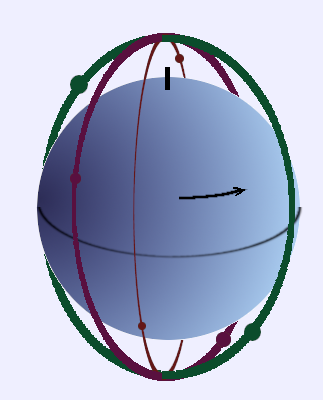
- Use polar orbits as the earth turns below.
- Have enough satellites on each orbit, and enough orbits,
that there's always at least one in view from any
point on earth.
- Base stations switch the between satellites, much
as cell phones in a moving car switch between towers.
- Satellites can forward between themselves until reaching
one in view of a desired base station.
- Trade-offs
- Major performance parameters:
- Channel capacity: Maximum data rate that can be sustained.
- Propagation delay: Time for a signal to traverse the medium.
- Cost: materials, installation, operation and maintenance.
- Quality of transmission: attenuation and distortion.
- Susceptibility to interference and noise.
- Security: susceptibility to eavesdropping.
- Maximum data rate.
- Receiving digital data from an analog signal is really a form
of sampling (more on this later). So,
the highest available frequency will produce two
levels per cycle.
- If there are K data levels, the maximum data rate D
for a signal of bandwidth B is given as
D=2Blog2K
- This is the “Nyquist Theorem,” which encourages fancy
encoding schemes.
- Limits on the data rate.
- Any transmission medium is subject to noise.
- May be interference.
- If you manage to clear that up, there are still
quantum effects.
- The “loudness” of the signal and of the noise are measured
in power (energy over time). The quantity
S/N is called the (wait for it)
“signal-to-noise ratio.”
- Shannon showed that noise limits transmission to
C=Blog2(1+S/N)
You can increase the signal strength, but:
- There are limits to how much energy you can pump in and transmit.
- The log means you don't get much improvement for a lot of
increased power.
- Creates a hard limit on the bandwidth of a particular channel.
- S and N are not usually given separately, but
signal-to-noise ratio is usually given as a single quantity,
expressed in decibels.
- A ratio of powers in decibels is given
- Example from text. A voice phone line.
- Analog bandwidth 3000 Hz.
- S-to-N of 30 dB, which gives S/N=1030/10=1000.
- C=3000×log2(1+1000)≈30,000
- This is a limit on the speed of a dial-up modem.
- Nyquest encourages fancy encodings. Shannon puts a limit on what you
can do with them.




